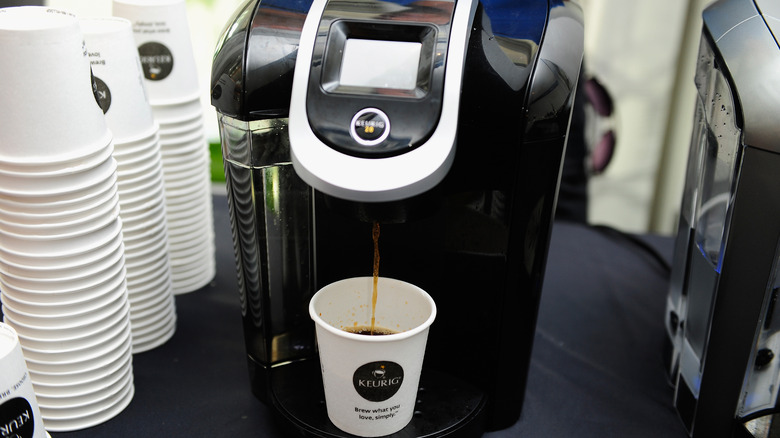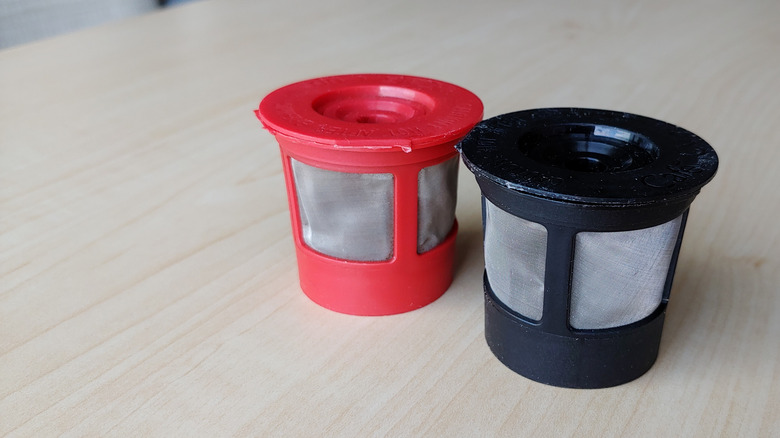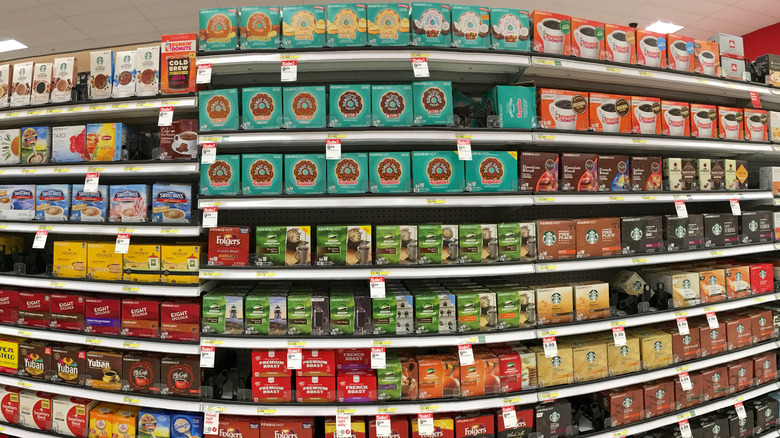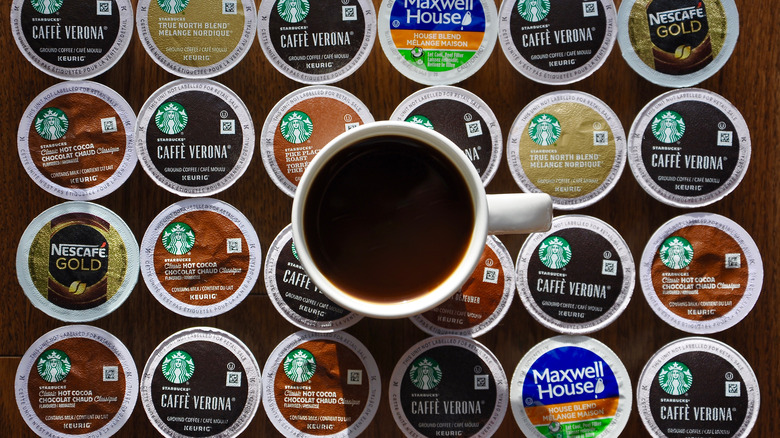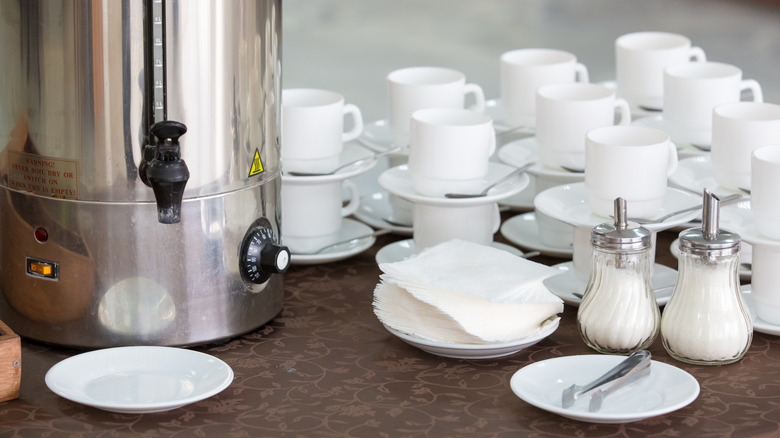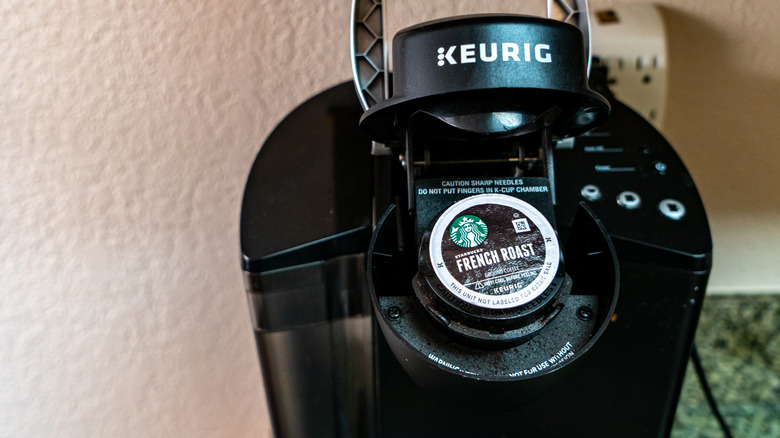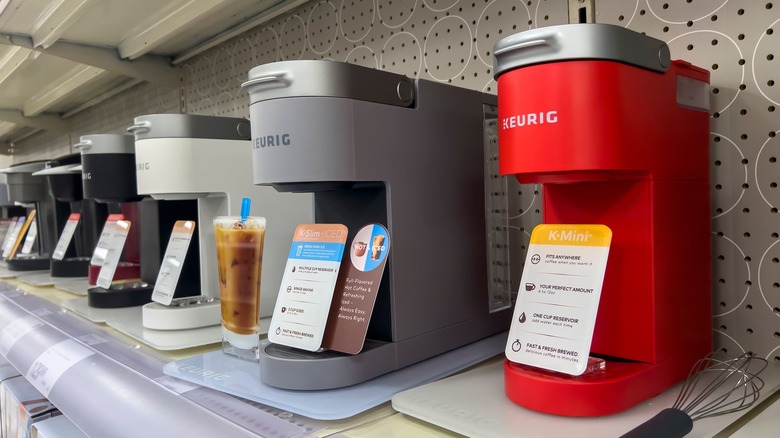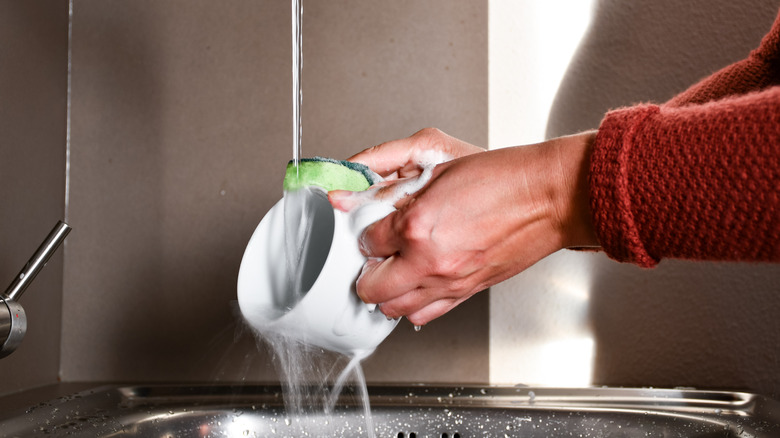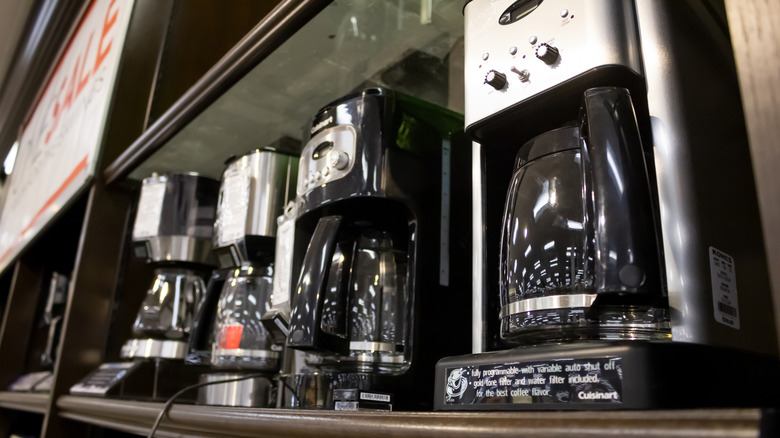The Hidden Downsides To Keurigs
Many Americans use Keurig coffee makers to make their morning brews. The device is all about convenience as users pop a pod in, and out comes their hot coffee. With new models being released, added features enhance the user's experience. According to Timetoast, the Keurig coffee maker and its K-Cups were first invented in 1990 by two college roommates, and they later founded the company in 1992. In the early 2000s, the business spread across the country before being bought out by Green Mountain Coffee in 2006. By 2010, the Keurig brand and its K-Cup line had become a billion-dollar industry.
However, using a Keurig as your coffee source has a few downsides. The cost and environmental impact of the machine make some users think twice. Plus, you might not get the best-tasting coffee and freshest grounds available. Here are a few Keurig cons to consider before committing to the products.
Keurigs wreak havoc on the environment
One of the most significant downsides of Keurigs is their impact on the environment and the amount of trash the K-Cups generate. Founder John Sylvan actually regrets inventing the coffee maker for this very reason. He tells CBC, "They're going to make those little plastic cups forever, because they can't think outside the box."
He goes on to say that Green Mountain's commitment to creating recyclable K-Cups is a false claim and that it needs to address the engineering process that leads to waste. With the number of Keurig users in the world, the amount of discarded K-Cups is astounding. In fact, there are enough discarded pods to circle the globe over 10 times (via Kill the K-Cup).
Sylvan's solution? He himself makes his coffee the old-school way with a timed maker and thermal carafe. There are also reusable K-Cups on the market to eliminate daily waste (via The Coffee Chronicler). However, these need to be cleaned and refilled after each use. This tedious process negates the convenience factor in opting for a Keurig in the first place, making them far from a perfect solution.
Relying on K-Cups limits your options and quality
When you have no choice but to use K-Cups, you can't select specific beans or ground available on the market. Sure, there are a ton of K-Cup options, and that number is growing. However, the brand lacks organic options and likely doesn't have K-Cups filled with roasts from your neighborhood coffee maker. This makes sticking with organic or local options tricky for Keurig users.
Buying locally roasted coffee comes with a whole host of benefits. As Honeybee Coffee points out, by buying locally, you support the farmers and roasters in your community. You also know that you'll be getting the freshest product available with enticing aromas and unique flavors. Being able to select from an assortment of freshly roasted local coffee blends just isn't possible with K-Cups.
Sticking with organic coffee can be a smart move. While coffee has its own list of health benefits, including reducing your risk of depression and certain cancers, non-organic coffee beans are grown with harsh chemicals and toxic pesticides (via Green Matters). Sticking with organic beans can eliminate these harmful ingredients while still giving you health perks. There's a small selection of organic K-Cups, but there are far more organic grounds and beans in regular packages on store shelves.
K-Cups give you lower-quality, less fresh coffee
With K-Cups, you're not getting the freshest coffee possible. As JavaPresse Coffee Company points out, K-Cups are manufactured with sheer quantities in mind and quality as a lower priority. Using low-grade beans, the K-Cups are often stale by the time they hit store shelves. Wholesale manager Elisa Nuchi tells Insider that these pods can sit there for months or even years before you take them home. But with coffee beans, she points out, "Once you grind it, it starts deteriorating immediately."
She also adds that the beans are exposed to oxygen after brewing. This exposure can destroy the coffee's taste and aroma. Instead, experts recommend freshly grinding your beans shortly before brewing. Instead of relying on stale K-Cup coffee, you can purchase a simple grinder with good features at a reasonable price (via Wired). Then, use a traditional coffee maker to brew a pot of the freshest coffee with the best flavor.
Using a Keurig is more expensive
Utilizing a Keurig to brew your coffee can be a budget-busting option. The price of using K-Cups versus traditional coffee can really add up. As The Manual explains, if you're a heavy coffee drinker that has three or more cups a day, you could be spending $657 to $876 more a year using a Keurig. With each pod costing an average of 60 cents each, those daily cups of joe add up to a significant line item in your budget. This can be especially true if you have more than one coffee drinker in your home.
Another downside to investing in a Keurig system is the initial cost of the coffee maker itself. Keurig machines can have significantly higher price points than other, simpler brewing methods (via Lucky Belly). So, if you are looking for a more fiscally conscious way to enjoy your coffee, opt for low-priced drip units or super budget-friendly French press pots.
Keurigs aren't great for hosting company
If you love hosting guests, a Keurig might not be the way to go. Sure, popping in a pod might be a great way to serve one guest a cup after dinner. But consider the amount of coffee you need to serve a whole crowd at breakfast or brunch. Plum Deluxe suggests making two cups of coffee per guest for a brunch event. If you have a large guest list, you'll be frantically refilling reusable pods or running through a ton of costly disposable ones.
You can make larger cups, up to 12 ounces, to serve larger portions. However, this can make the coffee watery and tasteless (via Cross Country Cafe). There are Keurig machines that can brew a whole pot. However, the coffee can come out weaker and less bold than typical coffee makers (via Mashup Mom). Plus, the machine is bulky and can be loud when brewing, the last thing you want during a party. Instead, opt for a coffee urn to provide piping hot coffee for your event (via Fluent In Coffee). These feature quality insulation and party-sized cup capacities. Plus, most designs feature an easy-to-use serving spout, perfect for guests to refill their cups independently.
Keurigs need tedious cleaning
Women's Health points out the need to regularly clean your Keurig coffee maker. It's recommended to take the machine apart and deep clean it once a month. This can be tedious and time-consuming, given the number of components in the device. However, it's necessary to keep the machine running well. Melissa Riker of The Happier Homemaker says, "If you allow the mineral deposits to build up, eventually it will lead to the water not getting hot enough, which not only gives you a lukewarm coffee but prevents you from tasting the full flavor of the coffee as well."
The needle that punctures the K-Cup to brew the coffee can also require special attention (via Homegrounds). This exit needle can get clogged and cause grounds to end up in your brewed cup. Cleaning this needle requires a special tool or a paperclip, a task that's not needed with other brewing methods. If you are looking for a low-maintenance brewing option, consider a basic drip model or pour-over coffee maker that's super simple to clean.
Keurigs don't have great reviews
When it comes to evaluating a product, some of the best feedback can come from other consumers. Expert product analysts can also help you determine everything from a product's performance to its projected reliability. The test engineers at Consumer Reports created a ranking of the best pod coffee makers. Because of the availability and popularity of K-Cups, many manufacturers have rolled out models that utilize them. When evaluated, the results show that Keurig doesn't typically make the top machines. In fact, only one of the manufacturer's models made the list. Two Cuisinart models get full marks for their temperature consistency, auto shutoff functions, and other special features. As for the Keurig that made the list, its drip function isn't top-notch. And as product engineer Ginny Liu points out, "Keurig models are a bit slower to brew the second cup of coffee compared to the top-rated pod coffee makers," which can be frustrating on busy mornings.
When it comes to the top coffee makers overall, there's a mix of drip and pod-utilizing models (via Consumer Reports). Drip brewers by brands like Cuisinart are praised for their brewing performance and owner satisfaction. For pod devotees, there are two Nespresso models on the list that receive exceptional ratings. Plus, the company recycles used pods for free. There is a Keurig-made model on the list that's praised for its consistency and features. However, it only received good marks for its heat-up time and below-average ratings for its reliability.
Single-cup coffee makers can harbor bacteria
One huge and possibly dangerous downside of Keurigs is the number of bacteria the machines can harbor. In a study done by CBS News, 10 single-serve coffee machines were swabbed and analyzed. Microbiologist Karen Deiss found 11 different types of bacteria and mold from the machines' samples. What's even more alarming is that coliform was found on multiple devices. This is a bacteria from the colon that can be transferred from unwashed hands and can cause anything from mild symptoms to severe illness. One-cup machines were found to have double the number of coliform than typical brewing machines.
Cleaning expert Melissa Maker tells Women's Health that much of the bacteria on your coffee maker is likely transferred through cross-contamination. Washing your hands can help keep the machine germ-free, but regular cleaning is also required. It's also recommended that you wipe it down daily and take it apart to clean it frequently. The single-cup process allows water to sit in the reservoir for longer, causing bacteria to grow. To prevent this, you'll have to remember to remove stagnant water when it's not regularly used.
Keurigs don't have a great warranty
As Consumer Reports points out, Keurigs only receive middle-of-the-road marks for reliability, not as promising as many other brands tested. This means that an iron-clad warranty is super important. However, Keurig only provides a one-year limited warranty for their machines. Plus, not using K-Cup brand pods, like those reusable options made by other manufacturers, can void this warranty. Many retailers allow you to purchase extended warranty plans. Of course, these come with an additional upfront cost.
Keep in mind that the average lifespan of a coffee maker is about five years (via Tom's Guide). So, if you want long-term reliability and longer warranty terms, you'll have to look to other brands. Some brands like Cuisinart come with up to three years of protection. And the top-of-the-line Technivorm coffee maker is an investment but comes with an impressive five-year warranty. With any warranty, read the fine print to see what components are covered, what actions could void it, and how to register your machine.
